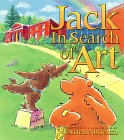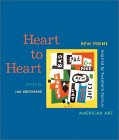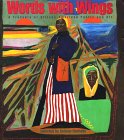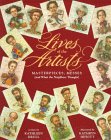
Literature:
Books:
Boehm, Arlene P.
Jack in Search of Art.
1998
ISBN: 1-57098-244-9
Preschool-Grade 3.
Jack searches for a person called Art throughout the inside and outside of a museum. While there he sees many paintings and sculptures and learns that art is everywhere.Clayton, Elaine.
Ella's Trip to the Museum.
1996
ISBN: 0-517-70080-8
Preschool-Grade 2
Ella participates in a field trip to a museum with her classmates. But only she seems to truly feel the art and participate in the dancing and flying occuring in the paintings.Greenberg, Jan (editor)
Heart to Heart: New Poems Inspired by Twentieth Century Art.
ISBN: 0-8109-4386-7
Grades 4 and up
This book pairs specially commissioned poems with twentieth century works of art that served as each poet's inspiration. The poems are grouped thematically into four sections and uses a wide variety of styles.Rochelle, Belinda (compiler)
Words With Wings: A Treasury of African-American Poetry and Art.
ISBN: 0-688-16415-3
Grades 4-10
In this anthology, twenty paintings by well-known black artists are reproduced opposite poems by famous black authors. The book includes short notes on both the author and the painter.Krull, Kathleen.
Lives of the Artists: Masterpieces, Messes (& What the Neighbors Thought).
ISBN: 0-15-200103-4
Grades 3-7
Twenty artist's lives are explored in this bok. The biographies are witty and humorous and are supplemented by notes at the end called "artworks" which contain additional facts.Quotations about portraits:
"By means of a back, we want a temperament, an age, a social condition, to be revealed; through a pair of hands, we should be able to express a magistrate or a tradesman; by a gesture, a whole series of feelings. A physiognomy will tell us that this fellow is certainly an orderly, dry, meticulous man, whereas that one is carelessness and disorderliness itself. An attitude will tell us that this person is going to a business meeting, whereas that one is returning from a love tryst. 'A man opens a door; he enters; that is enough: we see that he has lost his daughter.' Hands that are kept in pockets can be eloquent. The pencil will be steeped in the marrow of life."
Edgar Degas (1834-1917), French Impressionist. Quoted by Edmond Duranty, La Nouvelle Peinture: A Propos du Groupe d'Artistes Qui Expose dans les Galleries Durand-Ruel, Paris, 1876, translated by Linda Nochlin and included in the Sources and Documents series, Impressionism and Post-Impressionism, 1874-1904, Englewood Cliffs, 1966.
"If the man who paints only the tree, or flower, or other surface he sees before him were an artist, the king of artists would be the photographer. It is for the artist to do something beyond this: in portrait painting to put on canvas something more than the face the model wears for that one day; to paint the man, in short, as well as his features."
James McNeill Whistler (1834-1903), American painter and etcher. The Gentle Art of Making Enemies, "Propositions" (1890). See aestheticism and art for art's sake.
"What is a face, really? Its own photo? Its make-up? Or is it a face as painted by such or such painter? That which is in front? Inside? Behind? And the rest? Doesn't everyone look at himself in his own particular way? Deformations simply do not exist."
Pablo Picasso (1881-1973), Spanish artist. Arts de France, no. 6 (Paris, 1946). Quoted in: Picasso on Art (edited by Dore Ashton, 1972).
"A portrait, to be a work of art, neither must nor may resemble the sitter . . . the painter has within himself the landscapes he wishes to produce. To depict a figure one must not paint that figure; one must paint its atmosphere."
Umberto Boccioni (1882-1916), Italian Futurist painter and sculptor. Technical Manifesto of Futurist Painting, April 11, 1910.
Math:
Create a graph or Venn diagram: Chart the differences and similarities of two portraits. Use the criteria developed in Lesson 1 to help students categorize themes and visual elements of the portraits.
Geometry and Art: Locate and identify examples of geometric shapes within the works of art.




